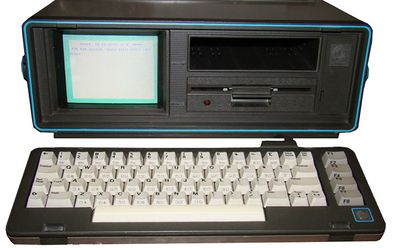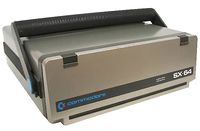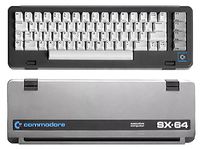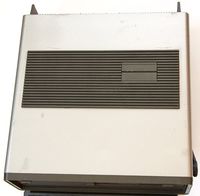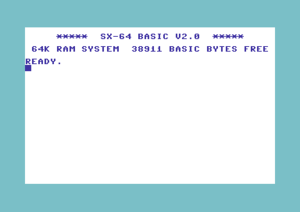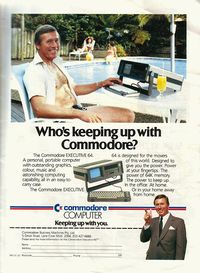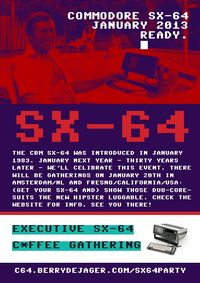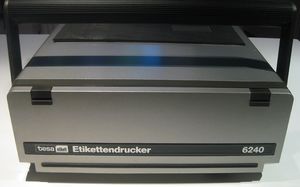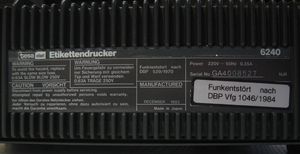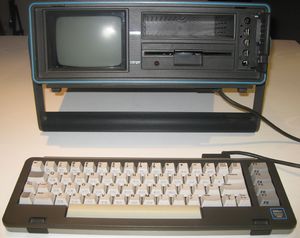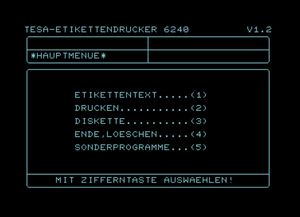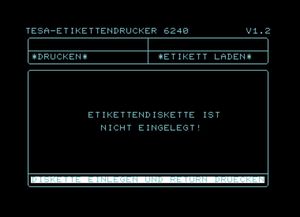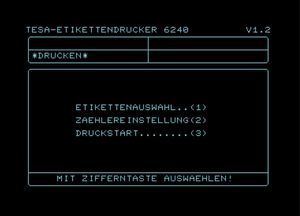Executive 64
| Executive 64 | |
| Type: | Home and Business Computer |
| Producer: | Commodore Business Machines |
| Price: | 995-1295 USD (1983 prices) |
| Released: | 1983 |
| Discontinued: | 1986 |
| Processor: | MOS Technology 6510 |
| Memory: | 64 kByte |
| OS: | BASIC V2.0 |
| Info: | alias SX-64, VIP64 |
The Commodore Executive 64 is the name of a family of portable computers based around the Commodore 64 architecture. Although not all models made it to distribution, the SX-64 did; and is considered the first full colour portable computer.
History[edit | edit source]
Commodore's idea was that the Executive 64 family would become the "affordable portable" and unveiled the first model at the Winter Consumer Electronics Show in Las Vegas in January 1983. Demonstrated as a prototype and called the SX-100, it was essentially a C64 with an upgraded kernal connected to a monitor and a half-height[1] disk drive packaged into a relatively small metal box. Proposed options[2] included a monochrome or a “color display” [3] from an integrated composite monitor, could be fitted with one or two floppy disk drives [4] and, allegedly, it “was battery powered” [5] although this was never part of the production model due to weight. Reportedly, Commodore proposed to have the first machine ready for 1 April 1983 [6] and by the Winter Consumer Electronics Show January 1984, the first Executive 64 was released as the SX-64[7]. There was evidence that it was also being offered at a discounted price of 750 USD. The next Executive 64 to be released was called the DX-64. It was to have an upgraded power supply and a second integrated floppy disk drive or modem by sacrificing the magnetically-shielded storage compartment. However, by February 1985 the DX-64 was reported as being suspended indefinitely [8]. The DX-64 was manufactured in very small amounts, and a number of working units have been confirmed to exist with "at least one known of in the U.S., and a few in Germany"[9]. Manufacturing ceased in 1986.
Contributors[edit | edit source]
Sig Hartman was director of software development for the Executive 64.
Models[edit | edit source]
SX stands for Single (drive) Executive, and DX stands for Double (drive) Executive.
| Table 1 - Executive 64 Family Models | |||||
|---|---|---|---|---|---|
| Name | Range | Price | Floppy Disk Drive | Monitor | Remarks |
| SX-100 | Prototype | n/a | 1x 5¼" 170 kB | color/monochrome | |
| SX-64 | Mid Range | 995 USD | 1x 5¼" 170 kB | color | • Known as the VIP-64 in Sweden. • The Swedish keyboard has characters å, ä and ö. • Sold by Handic Electronic Ab, Sweden. |
| DX-64 | Top Range | 1295 USD | 2x 5¼" 170 kB | color | |
Construction[edit | edit source]
| Table 2 - Construction of the Executive 64 | ||
|---|---|---|
| Aspect | Detail | Image |
| Dimensions | • Width: 14.7" (36.8 cm) • Depth: 14.7" (36.8 cm) • Height: 5" (12.7 cm) • Weight: 23 lbs (10.5 kg) |
|
| Cover | • Reversible lid with 66-key Keyboard featuring: •• 4x function keys, F1 -F8 , shifted and non-shifted •• RUN STOP , CAPS LOCK , INS DEL , CLR HOME •• 2x shifted cursor keys |
|
| Front Side | • Up to 2x 5¼" 170 kB Floppy Disc Drive • Magnetic-shielded compartment[10](where only one disk drive is installed) • 5” CRT monitor (black and white or colour) • Hinged flap concealing 5x twist knobs, 2x adjuster screws, 1x press button: •• volume (knob) •• sub contrast (screw) •• contrast (knob) •• sub bright (screw) •• bright (knob) •• color (knob) •• reset (button) •• v. hold (knob) |
|
| Top Side | • Cartridge port with spring-loaded fold-in lid | |
| Rear Side | • Control port #2 (DE9M connector) • Control port #1 (DE9M connector) • Analog Video Port (RF Modulator connector) • Serial Port (6-pin DIN connector) • User Port (24-pin male edge connector) • Expansion Port (44-pin male edge connector) • Power Port (3-pin IEC C14 male connector) • Panel mount fuse holder • Off/On Power Rocker Switch |
|
Technical Specification[edit | edit source]
Identical to the Commodore 64 with the following exceptions:
Form[edit | edit source]
- All components fitted into a pressed steel case with plastic trim.
- Carried by a sturdy plastic-covered steel handle, which doubles as an adjustable stand.
- Floppy disk storage compartment above disk drive 0.
Video[edit | edit source]
- Integrated display (5" (127 mm) composite color monitor CRT).
- Video out connector.
- No RF modulator & connector.
Audio[edit | edit source]
- Internal speaker.
Floppy Disc[edit | edit source]
- Integrated 170 kB 5¼" floppy disk drive (half-height version of the Commodore 1541).
Power[edit | edit source]
- Standard three-prong IEC C14 AC power connector.
- Internal switched power supply unit with transformer and rectifiers (later SX-64 units (from GA4 serial numbers onward) use the larger power supply intended for the DX-64).
- Integrated heat sink (in the rear panel).
Input/Output[edit | edit source]
- Separate keyboard unit (integrated to the front panel that protects the screen and connected via a cord and non-standard 25-pin (similar to, but not, a D-subminiature) keyboard connector).
- Integrated cartridge port (on top of unit, with a spring-loaded fold-in lid, cartridges inserted vertically).
- Integrated serial interface.
- Integrated user port.
- No datassette port.
Operation[edit | edit source]
The system requires a power source, as there is no internal battery pack. The carry handle can be adjusted and is intended to act as a variable height stand in order to optimise the viewing angle. The front cover unclips to reveal the keyboard; it is connected to the motherboard at the bottom of the unit via a cable and a D-Pin plug. The on-off rocker switch is at the rear of the machine. From a cold or warm boot (with no cartridge in place), the monitor displays a white (colour 1) background with blue (color 6) text and a cyan (colour 3) border . The startup message (will alter between SX-64 and DX-64) reads:
***** SX-64 BASIC V2.0 ***** 64K RAM SYSTEM 38911 BASIC BYTES FREE READY
Although this display defaults to the in-built 5" monitor, an external monitor can be hooked-up to view a larger picture with both monitors displaying the same content. As there is a built-in monitor, Commodore did not install any connectivity for a television and consequently there is no RF modulator or antenna connector. It was reported that there would be a slide-in television tuner[11], but it never materialised. The default device for load and save operations is the floppy drive 0 (device 8) as there is no datassette (device 1) capability. This means there is no requirement for naming which port the computer should use for load and save operations. The load shortcut (SHIFT and RUN STOP ) therefore refers to floppy drive 0. The reset button allows for a warm boot.
Compatibility Issues[edit | edit source]
Although the Executive 64 family is supposed to "support all the same software, peripherals and goodies as the stay-at-home-64"[12], there are a number of issues:
Datasette Port[edit | edit source]
The datasette port on the C64 has a +5V pin which has been used to provide power to some third party external peripherals. Such devices which utilised the Centronics parallel printer interface could workaround this problem by receiving a supply from a number of sources: through an interface for an AC power supply; by a connection to the Centronics port (pin 18); or an adaptor to connect to a control port.
Power Supply[edit | edit source]
The original built-in power supply of the SX-64 limited expandability. This was rectified with an upgraded power supply on later production runs (from GA4 serial numbers) and the DX-64 model.
Cartridges[edit | edit source]
There are some PCB differences which have led to compatibility problems with some C64 cartridges. The top-loading cartridge port in early models had improper shielding, being nothing more than a ribbon cable to the mainboard, and REUs and later cartridges would not work correctly in it. The problem was so bad that Commodore was forced to put out a service pack to replace the ribbon cable with a sturdier one[13].
Memory Expansion[edit | edit source]
Compatibility with Commodore RAM Expansion Units varies. Early SX-64 power supplies (prior to GA4 serial numbers) cannot handle the extra power consumption of the REU. The physical placement of the cartridge port can prevent the REU from seating properly. The 1700 and 1750, 128K and 512K units intended for the C128, are said to work more reliably with the SX-64 than the 1764 unit that was intended for the regular C64. Some SX-64 owners modify Commodore REUs to use an external power supply in order to get around the power supply issues.
Sales[edit | edit source]

Sales of the Executive 64 were poor, despite Don Richards (Commodore USA president) claiming that the SX-64 "has been a sellout everywhere"[15]. The exact number of SX-64 units sold is unknown but estimated to be less than 9k. This extrapolation has been made from the serial numbers of roughly 130[16] SX-64s from series GA1, GA2, GA4, GA5 and GA6. The ranges of numbers reported are: 49,000 for series GA1; 1,000 for GA2; 17,000 for GA4; 11,000 for GA5; and 7,000 for GA6. The reason for its commercial failure, and cease of its manufacture in 1986, has been attributed to a number of reasons.
Small Screen[edit | edit source]
With available CRT technology, the larger the screen, the heavier the computer. Therefore the 5" monitor is a trade-off of weight versus cost versus size. It is not easy to read the screen, but at the time critics were generally positive about its clarity. That said, it obviously compares poorly with a standard monitor or large television screen.
High Weight[edit | edit source]
There is lot of metal in the box and it still weighs 26 lbs. It has often been referred to as "luggable" rather than "portable" although is still lighter than a C64 with the peripherals required to run at remote locations.
Bad Marketing[edit | edit source]
The advertising was very poor when compared to the campaign for the C64. The Executive 64 is rarely seen being carried, and demonstrates little of its professional and portable capacity. Some potential buyers also held off on a purchase when the DX-64 was announced which came too soon in the SX-64 sale cycle. Consequently, the DX-64 never became widely available due to the slow sales of the SX-64, creating a Catch 22 situation similar to that endured by Osborne after announcing an improved version of its computer.
Software Library[edit | edit source]
A series of software packages were developed to target the portable computer user but were not of the quality of rivals. The lack of a mouse to drive the applications was also a hurdle.
Competition[edit | edit source]
There were other computers at the same time which gave the same, or a better, performance than the Executive 64. The Osborne 1 and Kaypro II (Zilog Z80 CPU, CP/M OS) competed at the 8-bit level, but the market was quickly to be dominated by new models such as the Compaq Portable (16-bit CPU, MS-DOS).
Niche Market[edit | edit source]
The SX-64 did however gain a following with user groups and software developers, who could quickly pack and unpack the machine to use for copying software or giving demonstrations.
Reception[edit | edit source]
Ahoy! Magazine, March 1983: Comments included "the keyboard was better than the 64's", also "the monitor isn't hard to read at all" and "the disk drive was durable enough for travel". While criticizing the lack of any provision for internal or external battery power, the magazine concluded that the average $750-800 retail price was "worth every penny!".
Run Magazine, May 1984: Comments included "I have to give the Executive 64 a solid four-star rating", "it's a dream to use", "it performs flawlessly" and not worried about the weight, "it's easy to take along with you". Concerning sales, it was was stated that "the dealers cannot get enough of them".
Revival[edit | edit source]
Even though it didn't sell well, it has aged particularly gracefully, and intact units command a respectable price today due to its novelty value. For a relatively uncommon unit during its heyday, they are now becoming more and more routinely seen and used by the modern Commodore retro-enthusiast. To celebrate the 30th birthday of the SX-64, enthusiasts hosted a party[17]at Starbucks in Amsterdam/The Netherlands, Fresno/California, Austin/Texas, Seattle/Washington and Toronto/Canada holding an online meeting using SX-64s[18].
Modifications[edit | edit source]
Some hobbyists and commercial companies have installed various peripherals in the SX-64's empty slot above floppy disc drive 0:
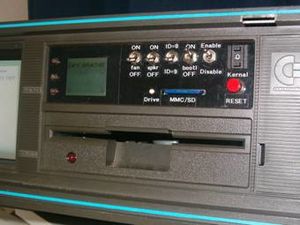 The 1541-III is a PIC microcontroller controlling a FAT16 MMC/SD card with .D64 files.[19] |
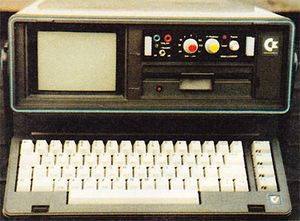 A plug-in module with oscilloscope switches for a home laboratory.[20] |
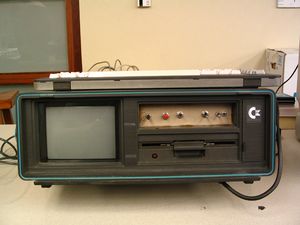 CRT power switch, reset, JiffyDOS on/off, drive on/off, and switches for the device number.[21] |
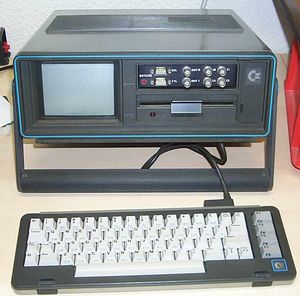 Commercial ADS Medical Datalog interface.[22] |
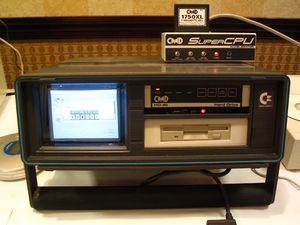 Playing audio CDs using a GEOS application.[23] |
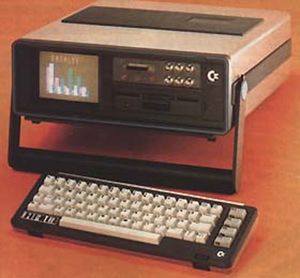 Commercial ADS Medical Datalog interface.[24] |
Aftermarket Conversion[edit | edit source]
In 1984, the German company Tesa had the requirement for their personnel to print labels in the field and commissioned a mobile computer called the Etikettendrucker (label printer). The Hamburg-based company ACOS made the conversions[25] from standard SX-64s into the Tesa 6240. The conversion, with the cost of each unit set at 10000 DM (1985 prices), resulted in a number of significant changes:
- Monitor was changed from color to green monochrome
- Front panel control knobs were removed
- SID was removed
- Kernal, BASIC and character ROM ICs was replaced with custom ROM ICs (ROM files are available for download[26]).
- Keyboard, logo and nameplate stickers were replaced
| The Tesa 6240 Etikettendrucker[27] | ||
|---|---|---|
Links[edit | edit source]
- SX64 dot NET, A place for SX64 users to fix, modify or get help for their SX, accessed 21 December 2014
- SX-64 Portable Computer Schematics, accessed 21 December 2014
- Vintage Computer, Commodore SX-64, accessed 21 December 2014
- Diagnosis and Repair/Upgrade of the Commodore SX-64, accessed 21 December 2014
- 8-bit Home Computers Museum, accessed 22 December 2014
- Commodore SX-64 Serial register, accessed 27 March 2022
References[edit | edit source]
- ↑ "Commodore's Port", Creative Computing, Volume 10, Number 2, Page 232, February 1984
- ↑ "New Computers at the Winter Consumer Electronics Show", Compute!, Volume 5, Number 3, Page 24, March 1983
- ↑ "1983 Winter Consumer Electronics Show; Creative Computing Presents the Short Circuit Awards", Creative Computing, Volume 9, Number 4, Page 18, April 1983
- ↑ "New Computers at the Winter Consumer Electronics Show", Compute!, Volume 5, Number 3, Page 24, March 1983
- ↑ "1983 Winter Consumer Electronics Show; Creative Computing Presents the Short Circuit Awards", Creative Computing, Volume 9, Number 4, Page 18, April 1983
- ↑ "New Computers at the Winter Consumer Electronics Show", Compute!, Volume 5, Number 3, Page 24, March 1983
- ↑ "The Commodore Story", zine.com, accessed 21 December 2014
- ↑ "Reviews: Commodore SX-64 Portable Computer", Ahoy!, Number 14, Page 38, February 1985
- ↑ "The Executive 64s: SX-64, DX-64, Executive 64, SX-100, SX-500", floodgap.com, accessed 21 December 2014
- ↑ "Commodore's Port", Creative Computing, Volume 10, Number 2, Page 232, February 1984
- ↑ "Meet the Affordable Portable", Run, Volume 1, Number 5, Page 48, May 1984
- ↑ "Meet the Affordable Portable", Run, Volume 1, Number 5, Page 48, May 1984
- ↑ "The Executive 64s: SX-64, DX-64, Executive 64, SX-100, SX-500", floodgap.com, accessed 21 December 2014
- ↑ YouTube video 5PygDf6E94o
- ↑ "Commodore Introduces New Family of Computers", Infoworld, Volume 6, Issue 6, Page 12, February 1984
- ↑ Unofficial Commodore SX-64 Serial Registry, accessed 22 December 2014
- ↑ 8-bit Living, accessed 21 December 2014
- ↑ Portland, Oregon, Commodore Users Club, accessed 21 December 2014
- ↑ Project: 1541-III, accessed 22 December 2014
- ↑ MOS 6502, A Commodore Geek's Blog, accessed 22 December 2014
- ↑ ECCC 2006, accessed 22 December 2014
- ↑ ADS SX-64, accessed 22 December 2014
- ↑ SWRAP Expo 2004, accessed 22 December 2014
- ↑ ADS SX-64, accessed 22 December 2014
- ↑ Forum 64,accessed 24 December 2014
- ↑ Retroport, accessed 24 December 2014]
- ↑ Retroport, accessed 24 December 2014
